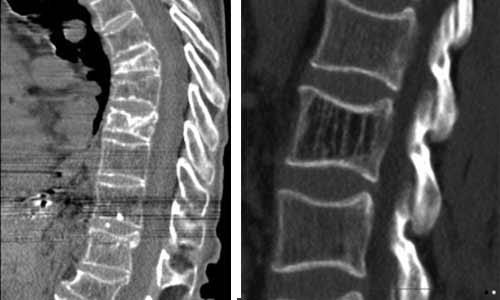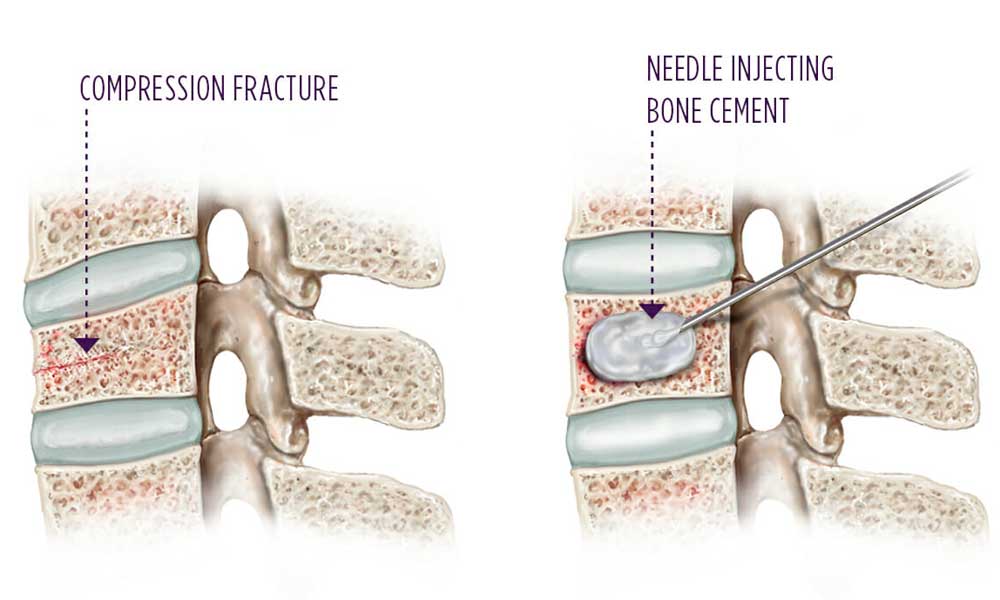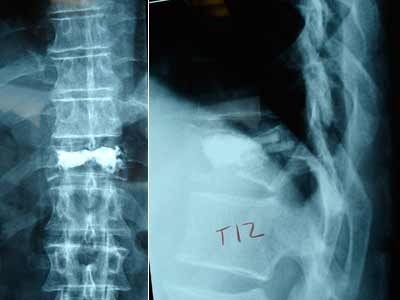What is Percutaneous Vertebroplasty?
Percutaneous vertebroplasty is a newer non-surgical technique in which medical grade cement is injected though a needle into a painful fractured vertebral body. This procedure stabilizes the fracture, enabling most patients to stop or greatly reduce pain medications and return to daily activities. Individuals who do not respond to standard treatments such as rest, pain relievers, and spinal bracing may be candidates for vertebroplasty.
About more than 5 crore people in India have osteoporosis (a decrease in the amount of bone mass) or have thinning of the bones that puts them at risk for spine fractures (broken bones). Thinning of the bones can occur at any time, but is most common in elderly persons. “Compression” fractures are caused when the weakened bone of the spine collapses either slowly or suddenly due to an impact. This usually causes severe back pain. When several of the bones collapse, loss of height or stooped posture may occur. Sometimes, the fracture gets better by itself and the pain goes away. In many patients, however, the pain continues because the crushed bone continues to move and break.
How are spinal fractures diagnosed?
The diagnosis of vertebral compression fractures is usually made by X-Ray, history, physical examination & MRI or CT scanning. MRI/ CT scan also helps to determine how much is the displacement of the bone and how much is the impingement on the spinal canal and to exclude other causes of back pain.

Indications for vertebroplasty
- The pain is severe and is because of a compression fracture
- Other, more conservative treatments haven’t relieved the pain
- The compression fracture is recently diagnosed and imaging tests (X-rays, MRI and bone scan) can pinpoint the location and age of the compression fracture
- The bones are not extremely weakened (porous) that ribs might break as a result of lying facedown during the procedure
Procedure
Most people can be treated as outpatients and return home the same day. During vertebroplasty sedation is given. Patient lie on the stomach. Back is numbed by local anesthesia and a small incision is made. Guided by X-ray cameras, your doctor injects bone cement into the damaged vertebra with a needle. Vertebroplasty usually takes one hour for each vertebra that is treated. You will need to lie flat on your back for two hours afterward while the cement hardens.
By percutaneous vertebroplasty other spine problems can also be treated
Percutaneous vertebroplasty is also useful in other painful or unstable benign and malignant vertebral lesions that fail to respond to the traditional conservative therapies like multiple myeloma, haemangioma and various spinal bone cancer.
What is the recovery like? And is the procedure safe?
A large number of patients experience immediate pain relief following vertebroplasty. The majority state that their discomfort is either completely resolved or significantly improved within two days. Most patients resume normal activity within 24 hours.
Vertebroplasty is very safe. The bone cement applied to stabilise the fracture is considered safe. However, individuals with spinal tumours may have a slightly higher risk of complications. It is important to review all potential risks of any procedure with your doctor.
How can I determine if vertebroplasty is the right treatment for me?
If you are experiencing severe back pain from a fractured vertebra due to osteoporosis that hasn’t improved after one to two weeks of rest and pain medication, vertebroplasty might be an appropriate treatment option. Newer fractures tend to respond better than older fractures; however, some older fractures can also be treated successfully.
How successful is vertebroplasty?
The success rate for this procedure in treating osteoporotic fractures is about 90-95%. Vertebroplasty is an effective option for managing aggressive vertebral hemangiomas and can also provide palliative relief for patients with malignant pathological fractures.
Vertebroplasty need any hospitalization?
It can be done as day care or one night hospitalization.
What are the advantages of vertebroplasty?
- Decreased pain. Vertebroplasty reduces and in some cases eliminates the need for pain medication, and it also restores mobility in many patients.
- Increased functional abilities. Vertebroplasty helps stabilize the fracture, significantly reduces pain, and enables patients to resume their normal activities.
- Prevention of further vertebral collapse. The cement occupies the porous areas of bone caused by osteoporosis, reinforcing the structure and reducing the risk of future fractures.
Dr. Pradeep Muley is trained in the USA and Singapore and has performed over 20,000 non-surgical treatments for various diseases like uterine fibroids, uterine adenomyosis, un-operable liver tumor, liver abscesses, varicose vein, brain aneurysm and vomiting of blood from lungs and stomach. He runs the VARICOSE VEIN AND FIBROID CLINIC AT FORTIS HOSPITAL, VASANT KUNJ, NEW DELHI & created INDIA’S 1ST UTERINE FIBROID CLUB. He has treated the maximum number of fibroid patients in India through the innovative Uterine Artery Embolization method.
For more in-depth information on various non-surgical treatments available-
Mail Us: muleypradeep@hotmail.com or Visit to Website: – www.indianinterventionalradiology.com
Phone or Whatsapp: +91-9810492778

